The Evolution of Galaxies
362-370
It is tempting to conclude that spirals evolve into ellipticals. Lets look at the "evidence"
- ellipticals are old (Pop II)
- spirals are young?
- "peel" away the spiral arms and you have an elliptical nucleus left behind?
Clusters of Galaxies
We live in a "crowded" galactic neighbourhood. Over there is Andromeda, to the right is M33, then there are the Magellanic Clouds, the Leo dwarf spheroidals and so on. Within a space about 1 Mpc in diameter are found the roughly 30 galaxies that comprise our Local Group . All orbit about the center of mass of the group and the Milky Way and Andromeda are by far the dominant members.
Further out we see a similar pattern repeated. 19 Mpc away is the very rich Virgo cluster - about 2500 galaxies crowded into a ball only 4 Mpc across! Further out at about 110 Mpc we find the Coma cluster and eventually, at a mind boggling 1000 Mpc we see the Hydra cluster.
We now realize that space between these clusters is the emptiest part of our universe and that galaxies tend to be gregarious by nature - always seeking companionship. We classify clusters of galaxies as either Rich Galaxy Clusters (more than a thousand members) or Poor Galaxy Clusters (less than a thousand members). Rich clusters are spherical, dense and contain a high proportion of elliptical galaxies with often one or two giant ellipticals in the centre of the cluster. Poor clusters are much less concentrated and irregular in shape. Our "local group" of galaxies is an example of a poor cluster.
Rich Clusters and Galactic Interaction
It's crowded if you are a galaxy! Consider the Virgo cluster. The density of galaxies is about 500/Mpc3 . Some very simple arithmetic tells us that galaxies are packed much more closely in clusters than the average star is in a galaxy. Galaxies are "packed" about 1020 times more densely than are stars! It is almost certain that the average star will not encounter another star during its lifetime. Conversely, it is almost certain that a galaxy will encounter another galaxy and in fact probably many times during its lifetime. Figure 13.16 shows the central portion of the distant galaxy cluster designated Abell2151.
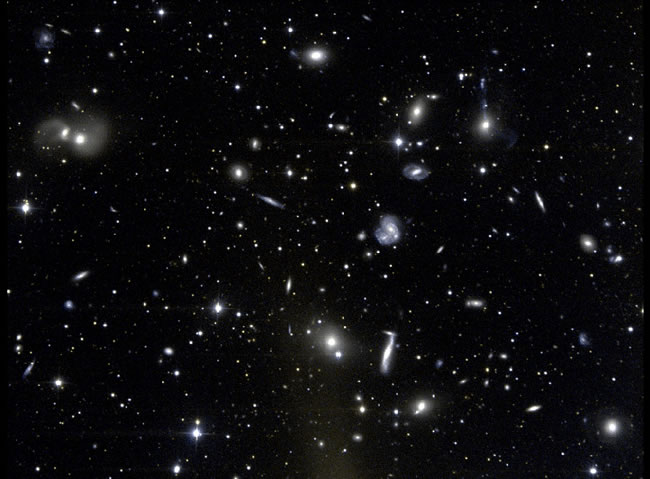 |
| Figure 13.16 The rich cluster Abell2151 in the constellation Hercules. (image courtesy KPNO). |
Note how many galaxies are in this frame and the type and distribution of the galaxies. This leads to some intriguing possibilities. How many indications of "galactic interaction" do you see in this image?
Modeling Galactic Interaction
Figure 13.17 presents the applet galaxyCollide which simulates the collision between two spiral galaxies. In this applet each galaxy consists of 5000 stars. By clicking the mouse over the image you initiate a new collision between galaxies (the galaxies are drawn with random orientations and velocities). Spend some time experimenting with the applet and see how many different patterns emerge when the galaxies collide. You can zoom in and out by using the up and down arrow keys.| Figure 13.17 |
Galactic Mergers and Starburst Galaxies
One consequence of galactic collision is the merger of galaxies to produce a more massive galaxy. The existence of very massive ellipticals in the centres of rich clusters also suggests that large galaxies can "cannibalize" smaller galaxies over time. In fact, there is very good evidence that our own Milky Way is cannibalizing some of its dwarf irregular neighbours. Finally, some galaxies show what appear to be several nuclei - again something which suggests that galaxies merge.
Galactic collisions and mergers can also induce rapid and widespread star formation. The compressive shock created when galaxies collide can trigger a "burst" of star formation and gives rise to what are called "Starburst galaxies". Figure 13.18 shows a example of this. The galaxy M82 has undergone a collision and star formation is occurring at a rate that is 10 times greater than what is observed in our own galaxy.
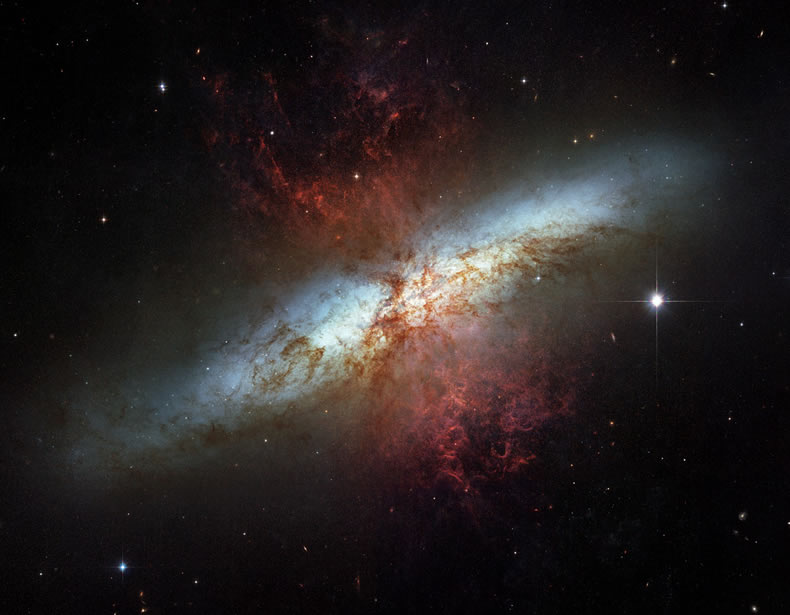 |
| Figure 13.18 Hubble image of the starburst galaxy M82. |
Example 13.12 Why is it reasonable to expect that Starburst galaxies will be very bright in the infrared wavelength region?
Solution: The initiation of star formation also results in widespread heating of the gas and dust clouds from which stars form. These hot clouds of gas and dust will glow brightly in the infrared.
Why are there Spiral and Elliptical Galaxies?
Galactic interactions, mergers and starburst activity are now providing a coherent picture for galaxy evolution. Elliptical galaxies are likely the end result of a starburst event. A violent starburst will quickly deplete available gas and dust. As well, spiral arms tend to fragile and a collision violent enough to create starburst conditions will also disrupt the spiral arms.
Spiral galaxies, on the other hand, appear to be galaxies that have not suffered violent collisions with their galactic neighbours. It is even possible that gentle, long-distance interactions with other galaxies may provide the perturbation needed to trigger and maintain the spiral density waves which produce spiral arms.
Images of clusters show that Elliptical and SO galaxies tend to populate, up to 90%, the centers of rich clusters of galaxies. On the edge, however, about 60% of the galaxies appear to be spiral. Furthermore, in the centers of many rich clusters we find a very large elliptical galaxy. Any conjectures?The Swiss-Cheese Universe
Swiss cheese is either cheese with holes or holes with cheese! It turns out that Swiss-Cheese is also a reasonable analogy for the large scale structure of our universe. In the 1980's the American astronomers Margaret Geller and John Huchra and others showed that the clusters of galaxies themselves tend to form in sheet or wall-like patterns that enclose empty regions (holes) that measure hundreds of millions of parsecs across. This structure is too "common" to be mere chance arrangement of clusters. Any model (cosmology) that we eventually come up with will have to explain how such enormous structures came into existence.
A Couple of "Geller Maps":
The little "homunculus" in the center of this map is composed of thousands of distant clusters of galaxies - not scattered at random but arranged in vast walls and sheets. The map is made by plotting redshift and position for thousands of galaxies. Since redshift is a measure of distance this is a way of sorting galaxies according to their distance from us. |
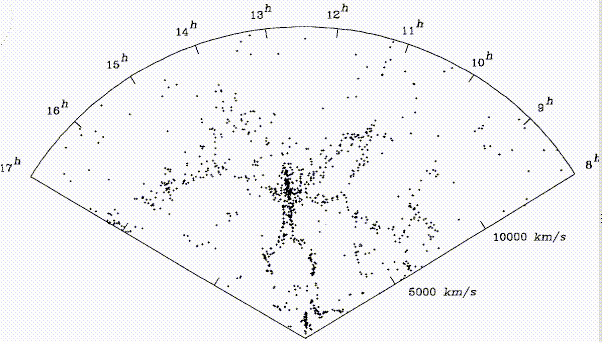 |
Figure 13.19 A "Geller Map" - galaxies mapped according to their redshift and position in space. |
|
| Figure 13.20 is another Geller map again showing that the distribution of galaxies is far from random. The largest structures known to us consist of these vast walls and sheets of galaxies and clusters of galaxies extending hundreds of millions of light years across space. | 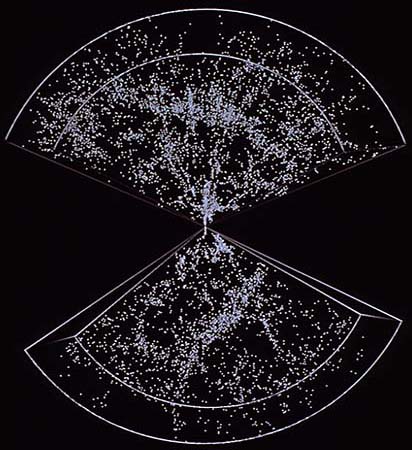 |
| Figure 13.20 Geller Map showing the largest scale structure known - "walls of galaxies" and voids. |
Practice
- What evidence is there for the idea that galaxies collide?
- Explain why elliptical galaxies are so poor in gas and dust.
- The following figure is a Hubble image of the galaxy ESO 510-G13. It is unusual because of the pronounced warp in its disk. Discuss how this warp may have originated.
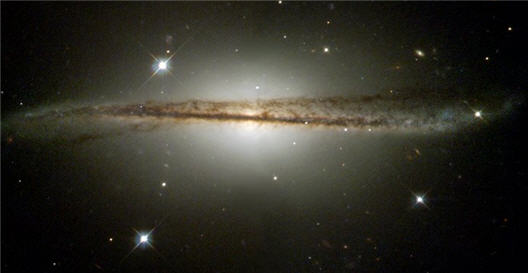 |
 To understand how the structure of galaxies change over time.
To understand how the structure of galaxies change over time.
Chp 16.3